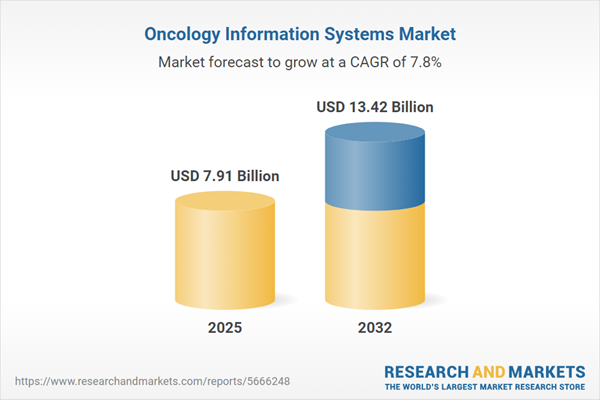Speak directly to the analyst to clarify any post sales queries you may have.
The oncology information systems market is evolving rapidly as healthcare institutions seek integrated, data-driven solutions to support complex cancer care and multidisciplinary workflows. These systems stand at the heart of transformative improvements in patient management, regulatory compliance, and clinical coordination.
Market Snapshot: Oncology Information Systems Market Growth and Outlook
The oncology information systems market grew from USD 7.37 billion in 2024 to USD 7.91 billion in 2025 and is projected to continue expanding at a CAGR of 7.78%, reaching USD 13.42 billion by 2032. This growth is driven by technological innovation, rising cancer incidence, and the need for seamless collaboration across care teams and digital platforms.
Scope & Segmentation
- Offering: Services and solutions, including consulting & training, installation & integration, maintenance & support, chemotherapy information systems, clinical integration solutions, laboratory information systems, medical image analysis & advanced visualization, oncology electronic health records, picture archiving & communication systems, vendor-neutral archives, radiation treatment planning, and radiology information systems.
- Functionality: Billing & revenue cycle management, clinical decision support, patient information & care management, regulatory compliance & reporting, and treatment planning & scheduling.
- Deployment Mode: Cloud-based and on-premise environments to address scalability, data sovereignty, and IT resource allocation.
- Application: Medical oncology, radiation oncology, and surgical oncology, each with specialized workflow and data needs.
- End User: Ablation & cancer care centers, hospitals & diagnostic imaging centers, and research facilities, reflecting various strategic priorities and resource profiles.
- Regions: Americas, Europe, Middle East & Africa, and Asia-Pacific. Key markets include the United States, Canada, Brazil, Germany, United Kingdom, France, China, India, Japan, and Australia, as well as several rapidly developing healthcare systems across the Middle East, Africa, and Southeast Asia.
- Leading Players: Major companies analyzed include Accuray, Advanced Data Systems Corporation, Elekta, Epic Systems Corporation, GE HealthCare, F. Hoffmann-La Roche, Fujifilm, Oracle, Tempus AI, Varian Medical Systems by Siemens Healthineers, RaySearch Laboratories, and Royal Philips, among others.
Key Takeaways for Senior Decision-Makers
- Oncology information systems have moved from being supportive tools to foundational digital infrastructure, enabling precise interdisciplinary clinical decision-making in cancer care.
- Emerging technologies such as artificial intelligence, cloud computing, and interoperability standards are accelerating system deployment, predictive analytics, and secure data exchange throughout healthcare networks.
- Market differentiation is intensifying as established vendors invest in proprietary platforms and modular solutions, while new entrants address niche needs like cloud migration and turnkey integration for mid-market cancer centers.
- Value-based care and regulatory imperatives are increasing demand for robust platforms capable of capturing outcomes data, supporting telehealth integration, and aligning with shifting reimbursement models.
- Global growth dynamics vary, with mature digital environments driving early adoption in North America and Western Europe, while emerging regions focus on leapfrog technologies and strategic partnerships for rapid catch-up.
Tariff Impact and Strategic Supply Chain Adjustments
- Recent United States import tariffs have added cost and complexity to hardware and equipment supply chains, propelling a trend toward localized production, alternative sourcing, and digital distribution of software licenses.
- Vendors are renegotiating service agreements and pivoting to flexible pricing models to navigate policy volatility, with increased emphasis on risk management and project timeline resilience.
Research Methodology & Data Sources
This report utilizes a multi-step methodology, combining primary interviews with healthcare IT leadership, oncologists, and administrative experts, along with secondary research from industry publications and regulatory records. Quantitative data was triangulated across multiple sources to ensure consistency, while industry analyst panels validated all findings and strategic conclusions.
Why This Oncology Information Systems Report Matters
- Streamline decision-making by revealing competitive dynamics, regulatory shifts, and the latest innovations shaping clinical, operational, and investment strategies in oncology information systems.
- Identify actionable opportunities based on granular market segmentation and regional dynamics, supporting optimized resource allocation and risk mitigation.
Conclusion
Successful adoption of oncology information systems depends on strategic investments in flexibility, interoperability, and emerging technologies. This report provides the insights senior leaders need to align transformation priorities with evolving patient care and industry requirements.
Additional Product Information:
- Purchase of this report includes 1 year online access with quarterly updates.
- This report can be updated on request. Please contact our Customer Experience team using the Ask a Question widget on our website.
Table of Contents
3. Executive Summary
4. Market Overview
7. Cumulative Impact of Artificial Intelligence 2025
Companies Mentioned
The companies profiled in this Oncology Information Systems market report include:- Accuray Incorporated
- Advanced Data Systems Corporation
- CompuGroup Medical, Inc.
- CureMD.com, Inc.
- DOSIsoft SA
- Elekta AB
- EndoSoft LLC by Utech Products Inc.
- Epic Systems Corporation
- F. Hoffmann-La Roche Ltd.
- FUJIFILM Corporation
- GE HealthCare Technologies Inc.
- International Business Machines Corporation
- Karkinos Healthcare Private Limited
- McKesson Corporation
- Medical Information Technology, Inc.
- MICA Information Systems, Inc.
- N-Power Medicine, Inc.
- NextGen Healthcare, Inc.
- Novarad Corporation
- Oracle Corporation
- RaySearch Laboratories
- Royal Philips
- Tempus AI, Inc.
- Varian Medical Systems, Inc. by Siemens Healthineers AG
Table Information
| Report Attribute | Details |
|---|---|
| No. of Pages | 194 |
| Published | November 2025 |
| Forecast Period | 2025 - 2032 |
| Estimated Market Value ( USD | $ 7.91 Billion |
| Forecasted Market Value ( USD | $ 13.42 Billion |
| Compound Annual Growth Rate | 7.7% |
| Regions Covered | Global |
| No. of Companies Mentioned | 25 |









